Business Strategy Case Study 2022
VerifiedAdded on 2022/09/16
|7
|1952
|16
AI Summary
Contribute Materials
Your contribution can guide someone’s learning journey. Share your
documents today.
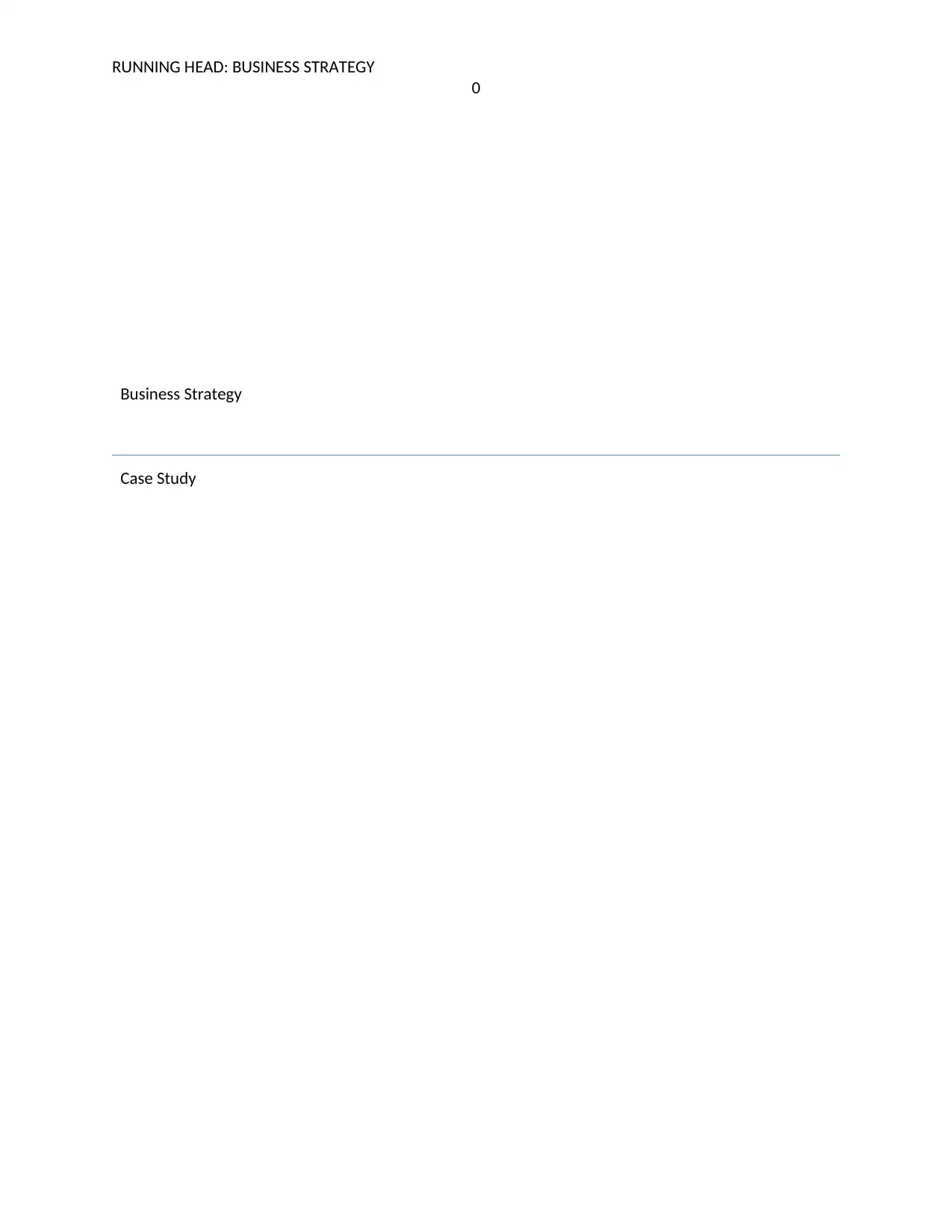
RUNNING HEAD: BUSINESS STRATEGY
0
Business Strategy
Case Study
0
Business Strategy
Case Study
Secure Best Marks with AI Grader
Need help grading? Try our AI Grader for instant feedback on your assignments.
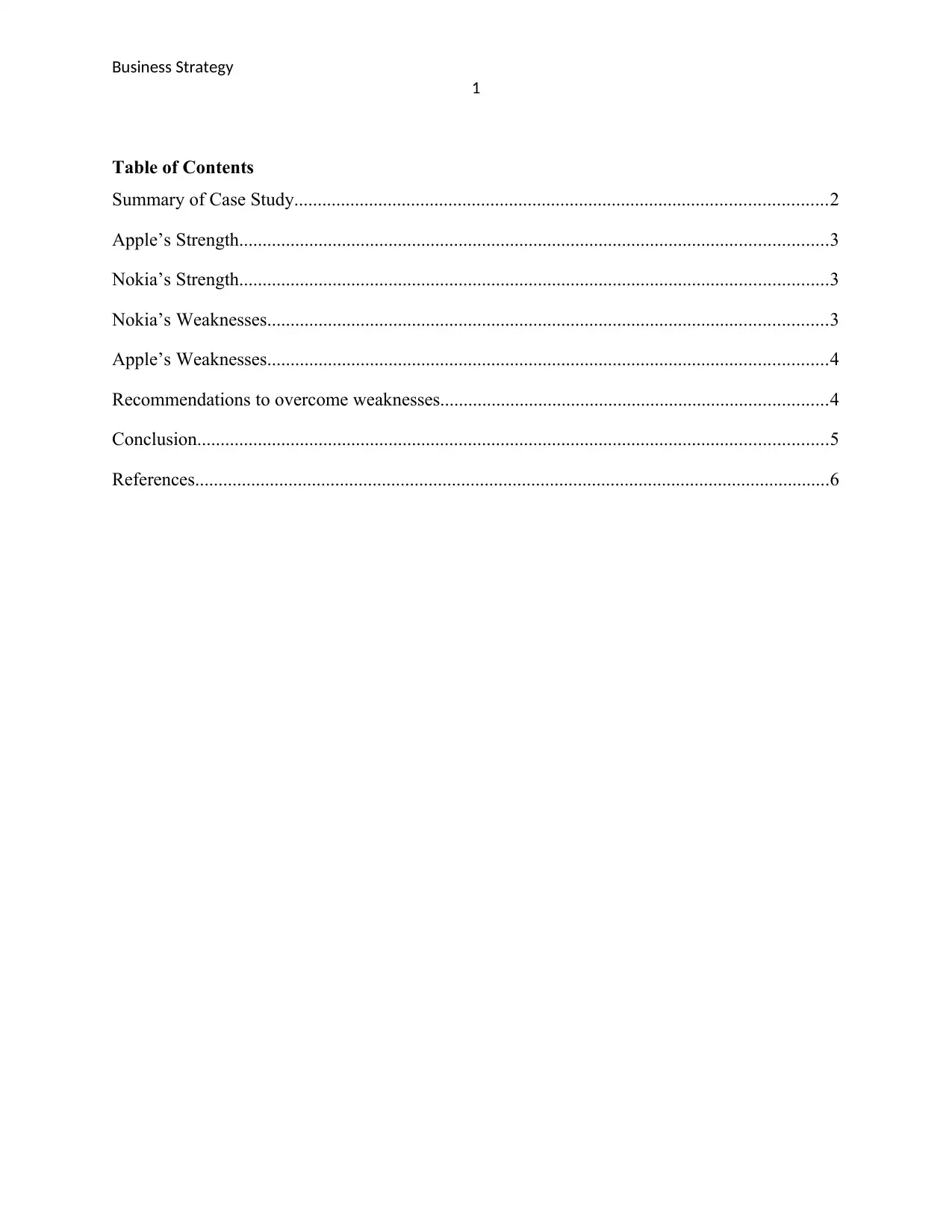
Business Strategy
1
Table of Contents
Summary of Case Study..................................................................................................................2
Apple’s Strength..............................................................................................................................3
Nokia’s Strength..............................................................................................................................3
Nokia’s Weaknesses........................................................................................................................3
Apple’s Weaknesses........................................................................................................................4
Recommendations to overcome weaknesses...................................................................................4
Conclusion.......................................................................................................................................5
References........................................................................................................................................6
1
Table of Contents
Summary of Case Study..................................................................................................................2
Apple’s Strength..............................................................................................................................3
Nokia’s Strength..............................................................................................................................3
Nokia’s Weaknesses........................................................................................................................3
Apple’s Weaknesses........................................................................................................................4
Recommendations to overcome weaknesses...................................................................................4
Conclusion.......................................................................................................................................5
References........................................................................................................................................6
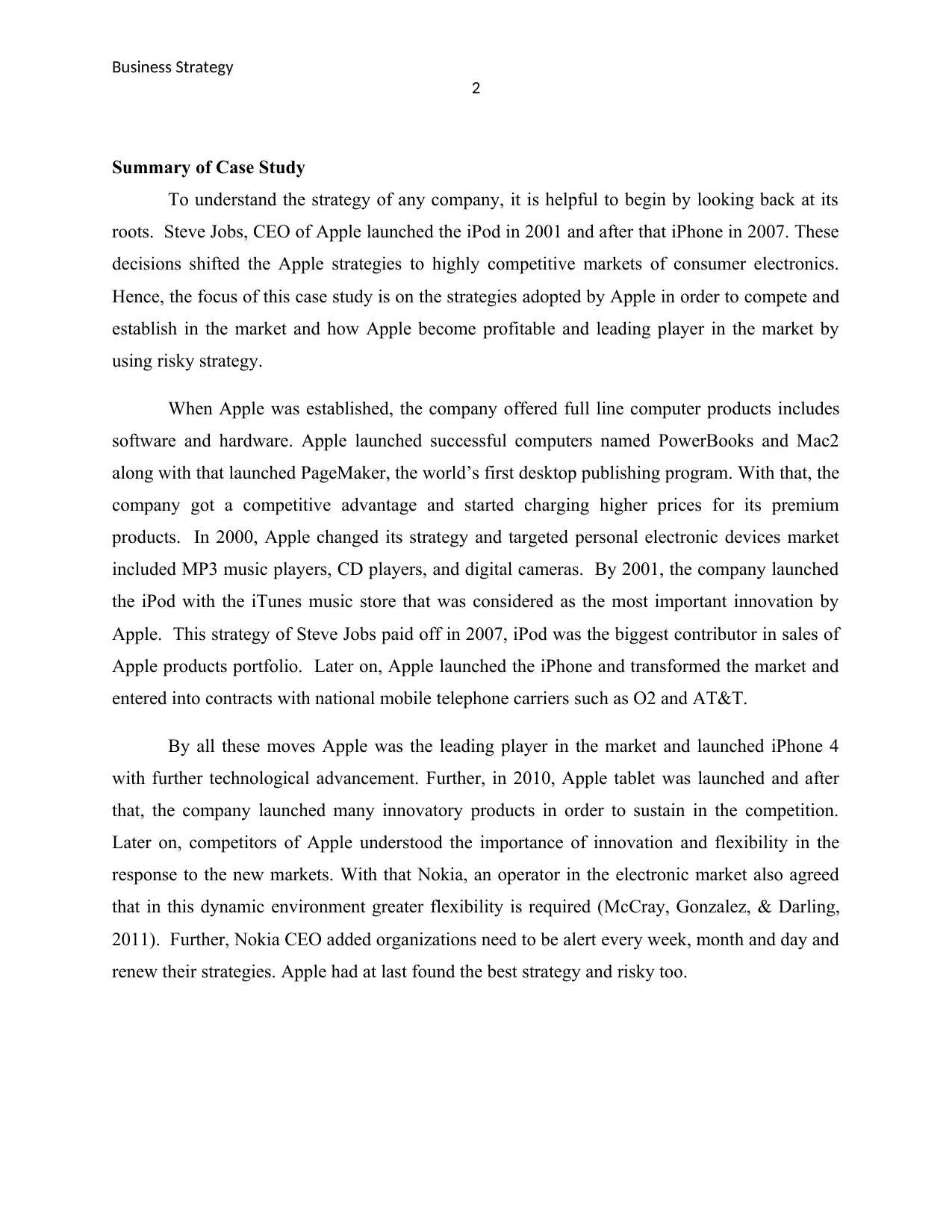
Business Strategy
2
Summary of Case Study
To understand the strategy of any company, it is helpful to begin by looking back at its
roots. Steve Jobs, CEO of Apple launched the iPod in 2001 and after that iPhone in 2007. These
decisions shifted the Apple strategies to highly competitive markets of consumer electronics.
Hence, the focus of this case study is on the strategies adopted by Apple in order to compete and
establish in the market and how Apple become profitable and leading player in the market by
using risky strategy.
When Apple was established, the company offered full line computer products includes
software and hardware. Apple launched successful computers named PowerBooks and Mac2
along with that launched PageMaker, the world’s first desktop publishing program. With that, the
company got a competitive advantage and started charging higher prices for its premium
products. In 2000, Apple changed its strategy and targeted personal electronic devices market
included MP3 music players, CD players, and digital cameras. By 2001, the company launched
the iPod with the iTunes music store that was considered as the most important innovation by
Apple. This strategy of Steve Jobs paid off in 2007, iPod was the biggest contributor in sales of
Apple products portfolio. Later on, Apple launched the iPhone and transformed the market and
entered into contracts with national mobile telephone carriers such as O2 and AT&T.
By all these moves Apple was the leading player in the market and launched iPhone 4
with further technological advancement. Further, in 2010, Apple tablet was launched and after
that, the company launched many innovatory products in order to sustain in the competition.
Later on, competitors of Apple understood the importance of innovation and flexibility in the
response to the new markets. With that Nokia, an operator in the electronic market also agreed
that in this dynamic environment greater flexibility is required (McCray, Gonzalez, & Darling,
2011). Further, Nokia CEO added organizations need to be alert every week, month and day and
renew their strategies. Apple had at last found the best strategy and risky too.
2
Summary of Case Study
To understand the strategy of any company, it is helpful to begin by looking back at its
roots. Steve Jobs, CEO of Apple launched the iPod in 2001 and after that iPhone in 2007. These
decisions shifted the Apple strategies to highly competitive markets of consumer electronics.
Hence, the focus of this case study is on the strategies adopted by Apple in order to compete and
establish in the market and how Apple become profitable and leading player in the market by
using risky strategy.
When Apple was established, the company offered full line computer products includes
software and hardware. Apple launched successful computers named PowerBooks and Mac2
along with that launched PageMaker, the world’s first desktop publishing program. With that, the
company got a competitive advantage and started charging higher prices for its premium
products. In 2000, Apple changed its strategy and targeted personal electronic devices market
included MP3 music players, CD players, and digital cameras. By 2001, the company launched
the iPod with the iTunes music store that was considered as the most important innovation by
Apple. This strategy of Steve Jobs paid off in 2007, iPod was the biggest contributor in sales of
Apple products portfolio. Later on, Apple launched the iPhone and transformed the market and
entered into contracts with national mobile telephone carriers such as O2 and AT&T.
By all these moves Apple was the leading player in the market and launched iPhone 4
with further technological advancement. Further, in 2010, Apple tablet was launched and after
that, the company launched many innovatory products in order to sustain in the competition.
Later on, competitors of Apple understood the importance of innovation and flexibility in the
response to the new markets. With that Nokia, an operator in the electronic market also agreed
that in this dynamic environment greater flexibility is required (McCray, Gonzalez, & Darling,
2011). Further, Nokia CEO added organizations need to be alert every week, month and day and
renew their strategies. Apple had at last found the best strategy and risky too.
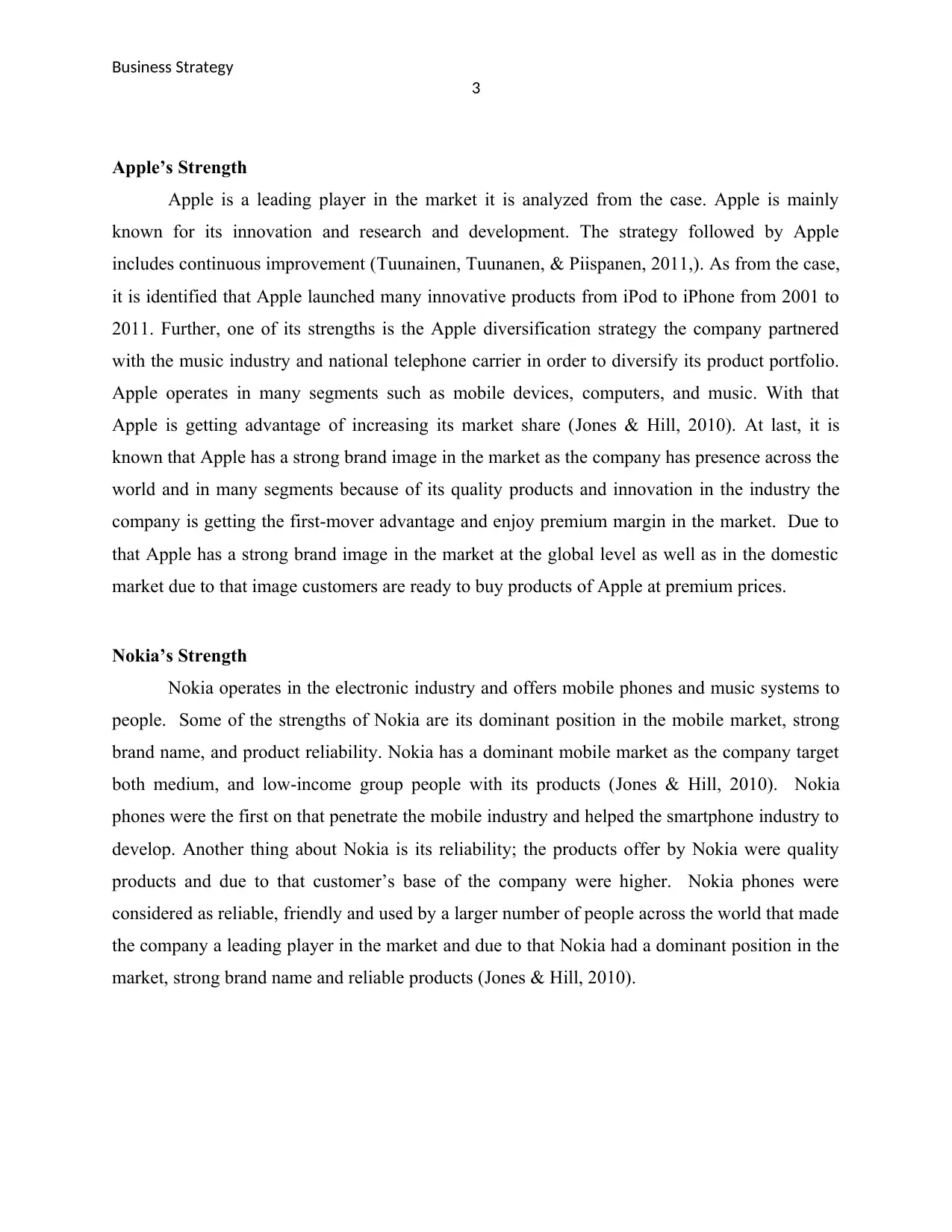
Business Strategy
3
Apple’s Strength
Apple is a leading player in the market it is analyzed from the case. Apple is mainly
known for its innovation and research and development. The strategy followed by Apple
includes continuous improvement (Tuunainen, Tuunanen, & Piispanen, 2011,). As from the case,
it is identified that Apple launched many innovative products from iPod to iPhone from 2001 to
2011. Further, one of its strengths is the Apple diversification strategy the company partnered
with the music industry and national telephone carrier in order to diversify its product portfolio.
Apple operates in many segments such as mobile devices, computers, and music. With that
Apple is getting advantage of increasing its market share (Jones & Hill, 2010). At last, it is
known that Apple has a strong brand image in the market as the company has presence across the
world and in many segments because of its quality products and innovation in the industry the
company is getting the first-mover advantage and enjoy premium margin in the market. Due to
that Apple has a strong brand image in the market at the global level as well as in the domestic
market due to that image customers are ready to buy products of Apple at premium prices.
Nokia’s Strength
Nokia operates in the electronic industry and offers mobile phones and music systems to
people. Some of the strengths of Nokia are its dominant position in the mobile market, strong
brand name, and product reliability. Nokia has a dominant mobile market as the company target
both medium, and low-income group people with its products (Jones & Hill, 2010). Nokia
phones were the first on that penetrate the mobile industry and helped the smartphone industry to
develop. Another thing about Nokia is its reliability; the products offer by Nokia were quality
products and due to that customer’s base of the company were higher. Nokia phones were
considered as reliable, friendly and used by a larger number of people across the world that made
the company a leading player in the market and due to that Nokia had a dominant position in the
market, strong brand name and reliable products (Jones & Hill, 2010).
3
Apple’s Strength
Apple is a leading player in the market it is analyzed from the case. Apple is mainly
known for its innovation and research and development. The strategy followed by Apple
includes continuous improvement (Tuunainen, Tuunanen, & Piispanen, 2011,). As from the case,
it is identified that Apple launched many innovative products from iPod to iPhone from 2001 to
2011. Further, one of its strengths is the Apple diversification strategy the company partnered
with the music industry and national telephone carrier in order to diversify its product portfolio.
Apple operates in many segments such as mobile devices, computers, and music. With that
Apple is getting advantage of increasing its market share (Jones & Hill, 2010). At last, it is
known that Apple has a strong brand image in the market as the company has presence across the
world and in many segments because of its quality products and innovation in the industry the
company is getting the first-mover advantage and enjoy premium margin in the market. Due to
that Apple has a strong brand image in the market at the global level as well as in the domestic
market due to that image customers are ready to buy products of Apple at premium prices.
Nokia’s Strength
Nokia operates in the electronic industry and offers mobile phones and music systems to
people. Some of the strengths of Nokia are its dominant position in the mobile market, strong
brand name, and product reliability. Nokia has a dominant mobile market as the company target
both medium, and low-income group people with its products (Jones & Hill, 2010). Nokia
phones were the first on that penetrate the mobile industry and helped the smartphone industry to
develop. Another thing about Nokia is its reliability; the products offer by Nokia were quality
products and due to that customer’s base of the company were higher. Nokia phones were
considered as reliable, friendly and used by a larger number of people across the world that made
the company a leading player in the market and due to that Nokia had a dominant position in the
market, strong brand name and reliable products (Jones & Hill, 2010).
Secure Best Marks with AI Grader
Need help grading? Try our AI Grader for instant feedback on your assignments.
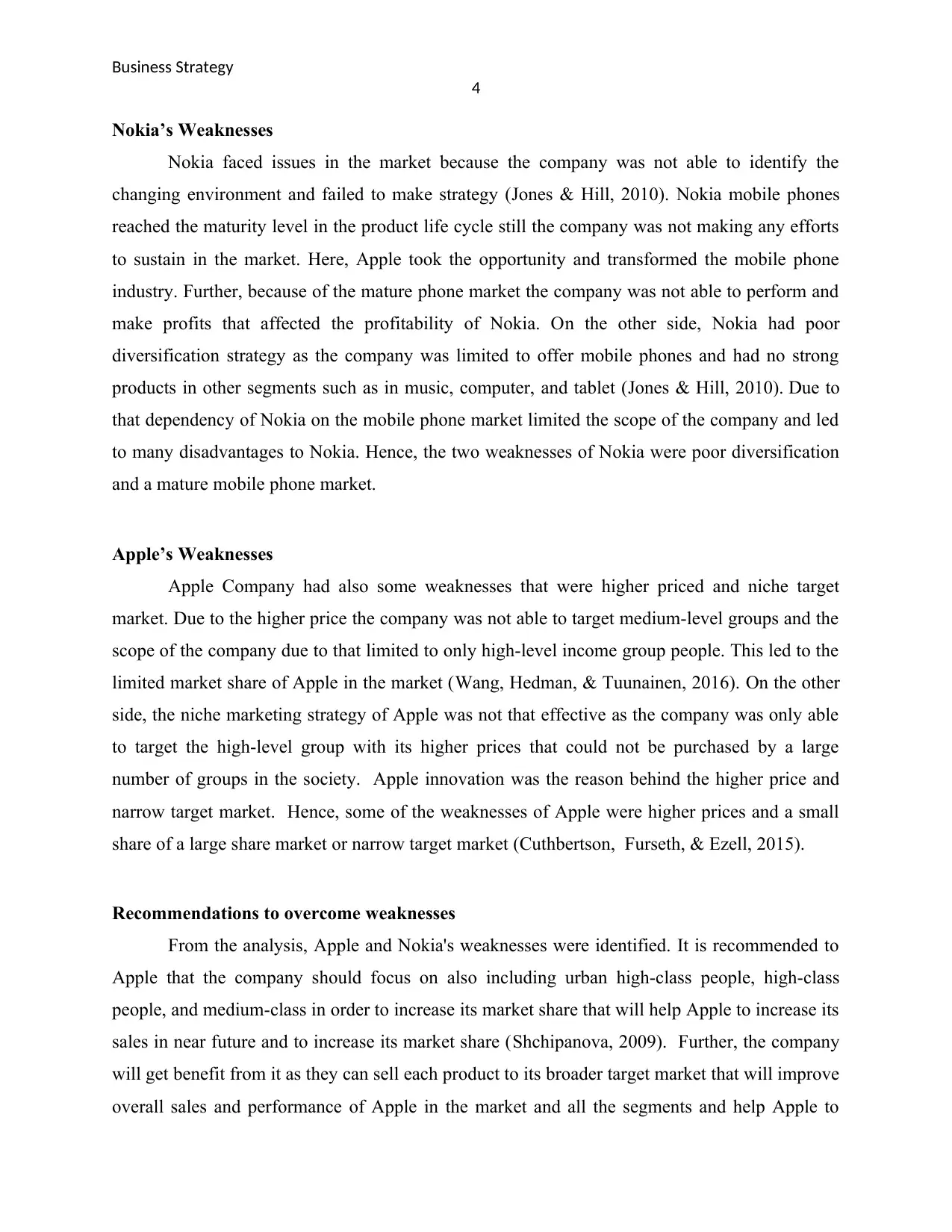
Business Strategy
4
Nokia’s Weaknesses
Nokia faced issues in the market because the company was not able to identify the
changing environment and failed to make strategy (Jones & Hill, 2010). Nokia mobile phones
reached the maturity level in the product life cycle still the company was not making any efforts
to sustain in the market. Here, Apple took the opportunity and transformed the mobile phone
industry. Further, because of the mature phone market the company was not able to perform and
make profits that affected the profitability of Nokia. On the other side, Nokia had poor
diversification strategy as the company was limited to offer mobile phones and had no strong
products in other segments such as in music, computer, and tablet (Jones & Hill, 2010). Due to
that dependency of Nokia on the mobile phone market limited the scope of the company and led
to many disadvantages to Nokia. Hence, the two weaknesses of Nokia were poor diversification
and a mature mobile phone market.
Apple’s Weaknesses
Apple Company had also some weaknesses that were higher priced and niche target
market. Due to the higher price the company was not able to target medium-level groups and the
scope of the company due to that limited to only high-level income group people. This led to the
limited market share of Apple in the market (Wang, Hedman, & Tuunainen, 2016). On the other
side, the niche marketing strategy of Apple was not that effective as the company was only able
to target the high-level group with its higher prices that could not be purchased by a large
number of groups in the society. Apple innovation was the reason behind the higher price and
narrow target market. Hence, some of the weaknesses of Apple were higher prices and a small
share of a large share market or narrow target market (Cuthbertson, Furseth, & Ezell, 2015).
Recommendations to overcome weaknesses
From the analysis, Apple and Nokia's weaknesses were identified. It is recommended to
Apple that the company should focus on also including urban high-class people, high-class
people, and medium-class in order to increase its market share that will help Apple to increase its
sales in near future and to increase its market share (Shchipanova, 2009). Further, the company
will get benefit from it as they can sell each product to its broader target market that will improve
overall sales and performance of Apple in the market and all the segments and help Apple to
4
Nokia’s Weaknesses
Nokia faced issues in the market because the company was not able to identify the
changing environment and failed to make strategy (Jones & Hill, 2010). Nokia mobile phones
reached the maturity level in the product life cycle still the company was not making any efforts
to sustain in the market. Here, Apple took the opportunity and transformed the mobile phone
industry. Further, because of the mature phone market the company was not able to perform and
make profits that affected the profitability of Nokia. On the other side, Nokia had poor
diversification strategy as the company was limited to offer mobile phones and had no strong
products in other segments such as in music, computer, and tablet (Jones & Hill, 2010). Due to
that dependency of Nokia on the mobile phone market limited the scope of the company and led
to many disadvantages to Nokia. Hence, the two weaknesses of Nokia were poor diversification
and a mature mobile phone market.
Apple’s Weaknesses
Apple Company had also some weaknesses that were higher priced and niche target
market. Due to the higher price the company was not able to target medium-level groups and the
scope of the company due to that limited to only high-level income group people. This led to the
limited market share of Apple in the market (Wang, Hedman, & Tuunainen, 2016). On the other
side, the niche marketing strategy of Apple was not that effective as the company was only able
to target the high-level group with its higher prices that could not be purchased by a large
number of groups in the society. Apple innovation was the reason behind the higher price and
narrow target market. Hence, some of the weaknesses of Apple were higher prices and a small
share of a large share market or narrow target market (Cuthbertson, Furseth, & Ezell, 2015).
Recommendations to overcome weaknesses
From the analysis, Apple and Nokia's weaknesses were identified. It is recommended to
Apple that the company should focus on also including urban high-class people, high-class
people, and medium-class in order to increase its market share that will help Apple to increase its
sales in near future and to increase its market share (Shchipanova, 2009). Further, the company
will get benefit from it as they can sell each product to its broader target market that will improve
overall sales and performance of Apple in the market and all the segments and help Apple to
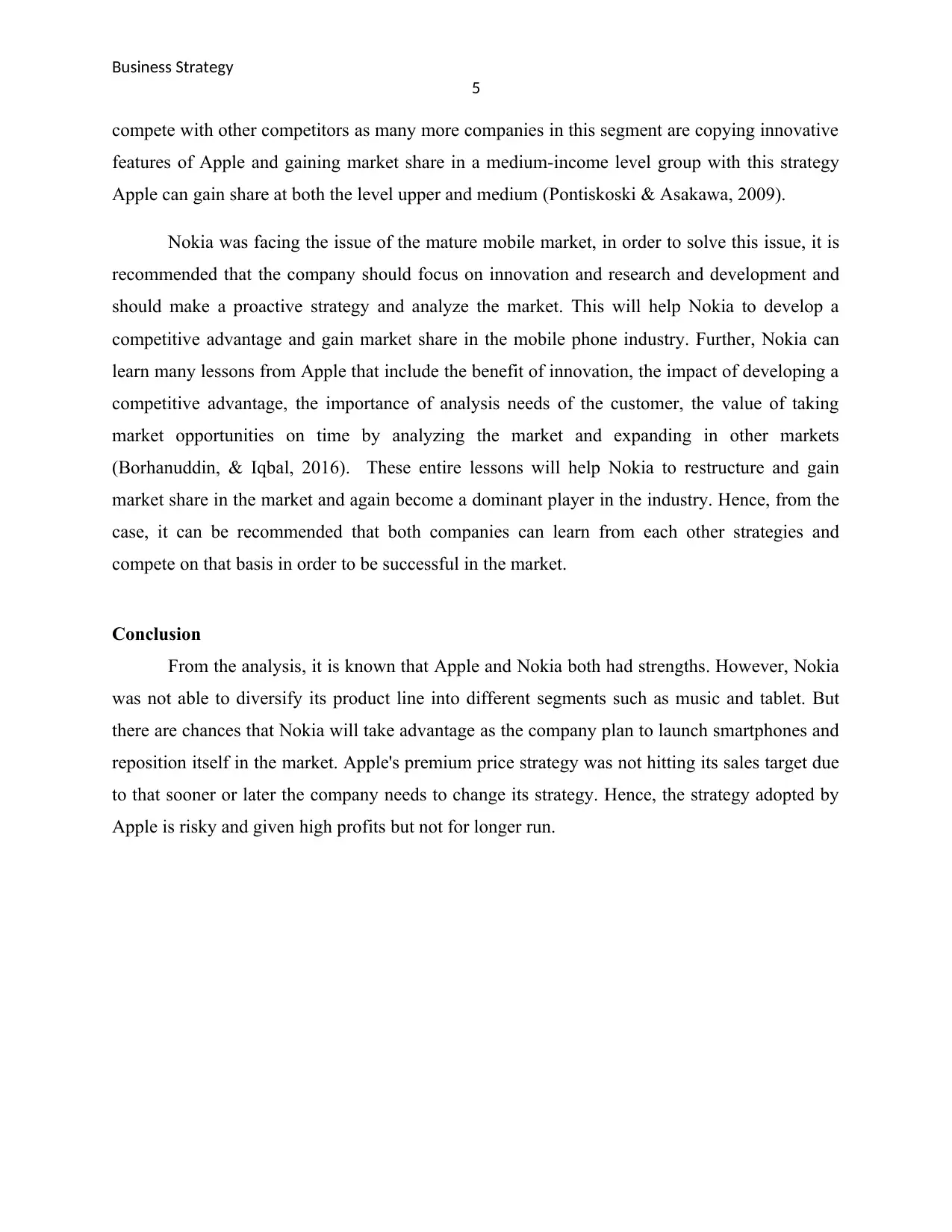
Business Strategy
5
compete with other competitors as many more companies in this segment are copying innovative
features of Apple and gaining market share in a medium-income level group with this strategy
Apple can gain share at both the level upper and medium (Pontiskoski & Asakawa, 2009).
Nokia was facing the issue of the mature mobile market, in order to solve this issue, it is
recommended that the company should focus on innovation and research and development and
should make a proactive strategy and analyze the market. This will help Nokia to develop a
competitive advantage and gain market share in the mobile phone industry. Further, Nokia can
learn many lessons from Apple that include the benefit of innovation, the impact of developing a
competitive advantage, the importance of analysis needs of the customer, the value of taking
market opportunities on time by analyzing the market and expanding in other markets
(Borhanuddin, & Iqbal, 2016). These entire lessons will help Nokia to restructure and gain
market share in the market and again become a dominant player in the industry. Hence, from the
case, it can be recommended that both companies can learn from each other strategies and
compete on that basis in order to be successful in the market.
Conclusion
From the analysis, it is known that Apple and Nokia both had strengths. However, Nokia
was not able to diversify its product line into different segments such as music and tablet. But
there are chances that Nokia will take advantage as the company plan to launch smartphones and
reposition itself in the market. Apple's premium price strategy was not hitting its sales target due
to that sooner or later the company needs to change its strategy. Hence, the strategy adopted by
Apple is risky and given high profits but not for longer run.
5
compete with other competitors as many more companies in this segment are copying innovative
features of Apple and gaining market share in a medium-income level group with this strategy
Apple can gain share at both the level upper and medium (Pontiskoski & Asakawa, 2009).
Nokia was facing the issue of the mature mobile market, in order to solve this issue, it is
recommended that the company should focus on innovation and research and development and
should make a proactive strategy and analyze the market. This will help Nokia to develop a
competitive advantage and gain market share in the mobile phone industry. Further, Nokia can
learn many lessons from Apple that include the benefit of innovation, the impact of developing a
competitive advantage, the importance of analysis needs of the customer, the value of taking
market opportunities on time by analyzing the market and expanding in other markets
(Borhanuddin, & Iqbal, 2016). These entire lessons will help Nokia to restructure and gain
market share in the market and again become a dominant player in the industry. Hence, from the
case, it can be recommended that both companies can learn from each other strategies and
compete on that basis in order to be successful in the market.
Conclusion
From the analysis, it is known that Apple and Nokia both had strengths. However, Nokia
was not able to diversify its product line into different segments such as music and tablet. But
there are chances that Nokia will take advantage as the company plan to launch smartphones and
reposition itself in the market. Apple's premium price strategy was not hitting its sales target due
to that sooner or later the company needs to change its strategy. Hence, the strategy adopted by
Apple is risky and given high profits but not for longer run.
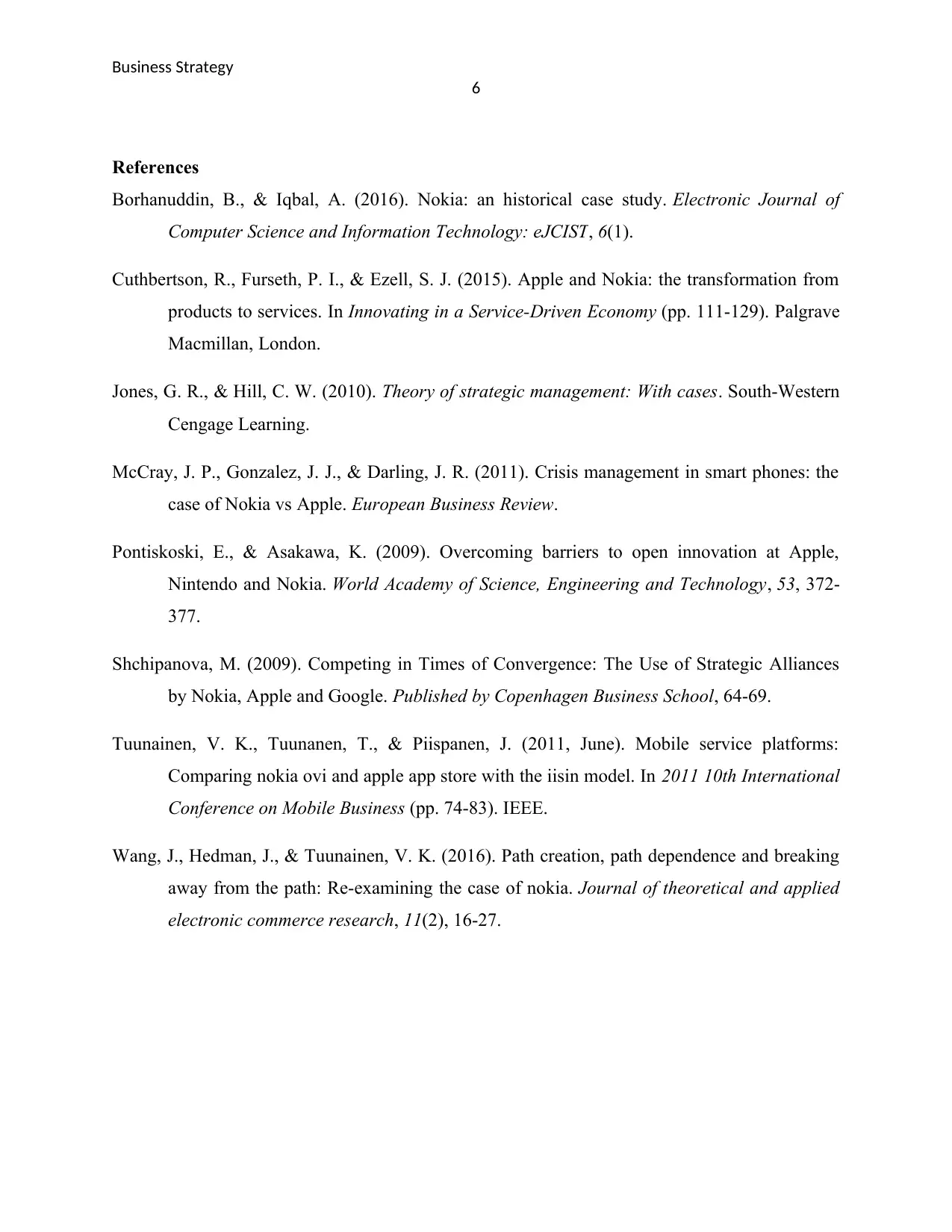
Business Strategy
6
References
Borhanuddin, B., & Iqbal, A. (2016). Nokia: an historical case study. Electronic Journal of
Computer Science and Information Technology: eJCIST, 6(1).
Cuthbertson, R., Furseth, P. I., & Ezell, S. J. (2015). Apple and Nokia: the transformation from
products to services. In Innovating in a Service-Driven Economy (pp. 111-129). Palgrave
Macmillan, London.
Jones, G. R., & Hill, C. W. (2010). Theory of strategic management: With cases. South-Western
Cengage Learning.
McCray, J. P., Gonzalez, J. J., & Darling, J. R. (2011). Crisis management in smart phones: the
case of Nokia vs Apple. European Business Review.
Pontiskoski, E., & Asakawa, K. (2009). Overcoming barriers to open innovation at Apple,
Nintendo and Nokia. World Academy of Science, Engineering and Technology, 53, 372-
377.
Shchipanova, M. (2009). Competing in Times of Convergence: The Use of Strategic Alliances
by Nokia, Apple and Google. Published by Copenhagen Business School, 64-69.
Tuunainen, V. K., Tuunanen, T., & Piispanen, J. (2011, June). Mobile service platforms:
Comparing nokia ovi and apple app store with the iisin model. In 2011 10th International
Conference on Mobile Business (pp. 74-83). IEEE.
Wang, J., Hedman, J., & Tuunainen, V. K. (2016). Path creation, path dependence and breaking
away from the path: Re-examining the case of nokia. Journal of theoretical and applied
electronic commerce research, 11(2), 16-27.
6
References
Borhanuddin, B., & Iqbal, A. (2016). Nokia: an historical case study. Electronic Journal of
Computer Science and Information Technology: eJCIST, 6(1).
Cuthbertson, R., Furseth, P. I., & Ezell, S. J. (2015). Apple and Nokia: the transformation from
products to services. In Innovating in a Service-Driven Economy (pp. 111-129). Palgrave
Macmillan, London.
Jones, G. R., & Hill, C. W. (2010). Theory of strategic management: With cases. South-Western
Cengage Learning.
McCray, J. P., Gonzalez, J. J., & Darling, J. R. (2011). Crisis management in smart phones: the
case of Nokia vs Apple. European Business Review.
Pontiskoski, E., & Asakawa, K. (2009). Overcoming barriers to open innovation at Apple,
Nintendo and Nokia. World Academy of Science, Engineering and Technology, 53, 372-
377.
Shchipanova, M. (2009). Competing in Times of Convergence: The Use of Strategic Alliances
by Nokia, Apple and Google. Published by Copenhagen Business School, 64-69.
Tuunainen, V. K., Tuunanen, T., & Piispanen, J. (2011, June). Mobile service platforms:
Comparing nokia ovi and apple app store with the iisin model. In 2011 10th International
Conference on Mobile Business (pp. 74-83). IEEE.
Wang, J., Hedman, J., & Tuunainen, V. K. (2016). Path creation, path dependence and breaking
away from the path: Re-examining the case of nokia. Journal of theoretical and applied
electronic commerce research, 11(2), 16-27.
1 out of 7
Related Documents
Your All-in-One AI-Powered Toolkit for Academic Success.
+13062052269
info@desklib.com
Available 24*7 on WhatsApp / Email
![[object Object]](/_next/static/media/star-bottom.7253800d.svg)
Unlock your academic potential
© 2024 | Zucol Services PVT LTD | All rights reserved.





